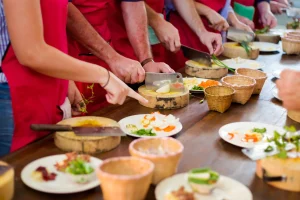Phuket has transformed into a highly sophisticated tourist destination with plenty to see and experience for all budgets. Although it is often known for its tropical paradise and infamous Patong nightlife, there is much more to enjoy on the island. In fact, Patong Beach makes up only a small portion of the island’s landmass, which is about 80% the size of Singapore. As the island has developed there has been a significant increase in accommodation and destinations outside of Patong.
Despite some believing that Phuket has lost its charm due to its popularity and development, we believe that the charm still remains, along with many new attractions. Visitors can enjoy some of the best beaches in the world, visit other tropical islands, zip through the treetops of the many tropical rainforests, watch spectacular, world-class, family-friendly shows, experience Thai-style nightlife, sample some of the world’s best cuisines, or shop at the numerous markets, duty-free emporiums and western-style shopping centres.
Despite these popular attractions, visitors can still find secluded beaches where they may not see anyone for the entire day. They can also find beachside restaurants serving delicious Thai food for just a few dollars, or visit temples where the daily routines have remained unchanged for centuries. The beaches, bars and temples are still here, there’s just so much more to see now.
In the 21st century, Phuket has also become a hub for eco-tourism. There are many eco-style tourist attractions, sustainable resorts, organic cooking classes, and eco-responsible interactions with elephants and the islands around Phuket. While Phuket is primarily known for its beaches, there is an entire hinterland of unspoiled hilly terrain, tropical rainforests, mangroves, waterfalls and sustainable marine activities.

Visitors can easily find responsible tour companies that prioritise Phuket’s long-term welfare, including visits to elephant parks that prohibit rides on elephants and concentrate on a sustainable interaction between the visitors and the elephants.
Old Phuket Town, which was once a rundown quarter of old Sino Portuguese shop houses, has been revitalized over the last 20 years. The town, located in the middle of Phuket Town, is now filled with cute cafes, funky galleries, and a variety of shops and boutique hotels. The local municipality has put all the power lines underground and repaved the footpaths, making it the perfect place to spend hours walking around, enjoying the architecture, and trying out the endless array of bars and restaurants.

PHOTO: Old Phuket Town Lard Yai market
Phuket is also Thailand’s largest island, making it the launching point for numerous day trips to the surrounding islands. Visitors can take trips through Phang Nga Bay, to Similan Islands (excluding monsoon season), to Koh Phi Phi, Koh Racha, Koh Naka, Coral Island and many more.
On Phuket itself, there are 32 excellent beaches where visitors can relax, get some sun, or go for a sunset walk.
All the most popular beaches are along th west coast of the island, providing a spectacular sunset view every night. While it may be too dangerous to swim at some times of the year, most beaches have lifeguards who put out red flags on days when swimming is prohibited.
Popular beaches include Patong, Karon, Kata, Kamala, Nai Harn and Bang Tao. However, there are plenty of other beaches with their own unique charm and landscape. Visitors can purchase drinks at any of these beaches, and some beaches even rent out sun lounges and umbrellas for around 100 baht.

For a nice slice of ‘local’ vibes, we highly recommends the Sunday Night ‘Lard Yai’ market in Thalang Road, which usually starts around 4 pm and runs until approximately 9 pm.
When it comes to Thai cuisine, Phuket has its own unique southern flavours that are worth exploring. There are plenty of cooking classes around the island that offer an authentic experience for visitors. From local markets to upscale hotels, you can usually find a class to suit your available times and budget.
One thing to note is that local Thai food in Thailand is different from the toned-down versions often found in other countries. In a Phuket cooking class, you can learn about the many spices and flavours that make up authentic Thai cuisine, including the southern Thai cuisine which has a focus on seafood and some hotter tastes.

Classes typically cover shopping for ingredients and cooking techniques that allow you to recreate these dishes back home.
Classes are usually offered in the morning, afternoon, or for a full day, and participants get to enjoy the fruits of their labor by eating the dishes they prepared. Many larger hotels in Phuket offer their own Thai cooking classes on-site, making it convenient for guests to participate.
Finally, street dogs, commonly known as soi dogs, are a familiar sight, although their presence has decreased over the past decade thanks to the efforts of several non-governmental organisations that have improved their quality of life along with that of soi cats.
One such organisation is the Soi Dog Foundation, based in Phuket, which is highly recommended for a visit. It is possible to make a brief or even a regular visit to participate in the daily care of the hundreds of dogs being housed on site.

The Foundation’s primary project involves sterilising around 12,000 animals annually, which has contributed to making the streets and roads of Phuket safer for all. The project entails capturing, neutering, rehabilitating, and, ideally, rehoming the animals. In some instances, however, the animals may not be suitable for a new “forever” home and will remain at the Foundation’s Mai Khao facility.
Other dogs end up traveling to distant destinations around the world, as owning a soi dog as a pet has become quite trendy. Despite their difficult start in life, soi dogs are typically very hardy and make excellent pets.
Volunteering to care for the animals or taking a guided tour of the Soi Dog premises in Mai Khao is certain to be a more fulfilling experience than many of the tourist attractions on the island.









